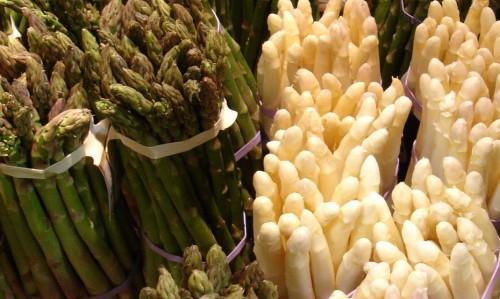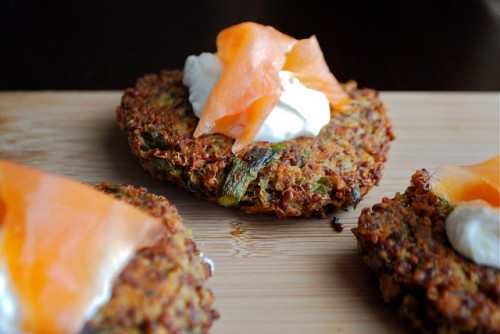Spargel season is slowly beginning here in Germany, which generally goes hand-in-hand with strawberry season. At the moment, a lot of what is available is still from France (especially the strawberries) but the first devilishly expensive German strawberries are also hitting the markets and it will be no time at all before there are Spargel stands on every corner.
Spargel, also known as asparagus, is a pretty big deal here in Germany and there are even local festivals to celebrate the harvest where you can eat asparagus prepared in every way imaginable for about a week (a lot of the local restaurants serve special Spargel dishes in addition to the basics served at the fair grounds).It is estimated that 82,000 tons of Spargel are actually produced here in Germany each year — which only meets about 61% of consumption needs. When I tell you that the Germans love asparagus, I’m really not kidding!
I have to admit that we have shied away from Spargel quite a bit in recent years. I don’t know if it was the sheer overload of seeing it talked about everywhere or just not being 100% certain what to do with the white variation which is so popular here. But the green is also beginning to be more readily available here and I’m looking forward to cooking up some Spargel this year.
What is the difference between Spargel and asparagus?
In Germany, Spargel is the term for asparagus, but it really is more commonly used to refer to the white variation which is so popular here. White asparagus is no different than regular asparagus, expect that it is grown underground in little mounds. Therefore, no photosynthesis occurs, keeping the stalks from turning green. The white variation has a slightly milder, sweeter flavor.
Green asparagus is usually best when picked early, because it will get every woody and tough. White asparagus, on the other hand, can be grown for a while and the thickness has no impact on the tenderness…but white asparagus should always be peeled before you prepare it. Never snap white asparagus lite you do the green — trim any woody ends off instead. You’ll waste far too much Spargel with the snap method.
When you buy asparagus fresh at the market, you can usually get it pre-peeled but you’ll want to eat it the same day you buy it. If you don’t get it peeled, you can store it just like salad in a damp dish towel in your refrigerator for an extra day. But this is definitely not something you buy on Tuesday to eat on Friday! Freshness matters if you don’t want tough stalks.
Buying Spargel
Finding a place to buy Spargel in Germany while it’s in season should not be an issue. The straighter the stalk, the higher the quality and the more you will pay (up to €12 or more per kilo) but it’s not going to taste any different if it’s crooked.
You want the Spargel to be fresh so you will need to examine the cut ends — ALWAYS ask before handling the produce at markets in Germany. Squeeze the cut end just a bit and see if you can produce a bit of liquid — if yes, it’s good!
The thickness of the stalk really doesn’t matter but a thicker stalk will be easier to peel — so keep that in mind if you’ll be peeling yourself. And get yourself a handy asparagus peeler which has the peeling blade turned perpendicular to your hand.
If you’re thinking about growing your own asparagus or buying it in bulk to can, read these 12 don’t about asparagus first!
Recipes to Try
- Paper-clip Asparagus with Crayfish
- Flammkuchen with Spargel and Black Forest Ham
I saw this recipe being prepared years ago on TV here in Germany and I just KNEW I had to try it. That was forever ago and I still haven’t. But this year will be the year. No really…although might go with shrimp if the Flusskrebs evade me.
Mmmh, Flammkuchen! I’ve been thinking about making one of these paper-thin pizza-like creations for a while now — but you know me. I won’t be satisfied with store bought dough…I may have issues!
So simple, so elegant, so delicious!
-
Asparagus and Goat Cheese Quinoa Patties with Smoked Salmon and Lemon Yogurt Sauce
This sounds divine — and the presentation is really lovely. We love making potato pancakes with sour cream and smoked salmon on them — so this could be a really interesting twist on those.






Asparagus, for me, is one of the most enjoyable things about spring. I love its crisp texture and nutty flavor when it is snapped into short pieces and put in a salad raw. When I cook it I steam it for a very short period of time and serve it with a Hollandaise Sauce. I actually prefer the stronger flavor of green asparagus and think that canned asparagus should be outlawed. 🙂
Peel it? I have been eating asparagus all my life and never even thought to peel it. Last year I had many variations of the bland white spargel served in Europe. I really prefer thin stalks of green. It has more flavor.
I hear ya, it ain’t asparagus. Spargel does need to be shaved, like cleaning a carrot. I find the taste refreshing and light. So, I think of spargel and asparagus as cousins not siblings. They normally serve spargel with hollandaise ( I like) but my wife prefers bernaise ( not bad) while asparagus needs nothing but a sprinkle of herbs/spices you desire while baking or steaming.
I’m very happy to read this. This is the type of manual that needs to be given and not the accidental misinformation that is at the other blogs. Appreciate your sharing this greatest doc.
I have recently started a blog, the information you offer on this web site has helped me tremendously. Thank you for all of your time & work.
I do love the way you have framed this specific issue plus it does supply me personally a lot of fodder for consideration. Nevertheless, from just what I have witnessed, I basically wish as other opinions pack on that folks continue to be on point and not start on a tirade regarding some other news du jour. All the same, thank you for this excellent point and though I can not go along with this in totality, I respect the viewpoint.